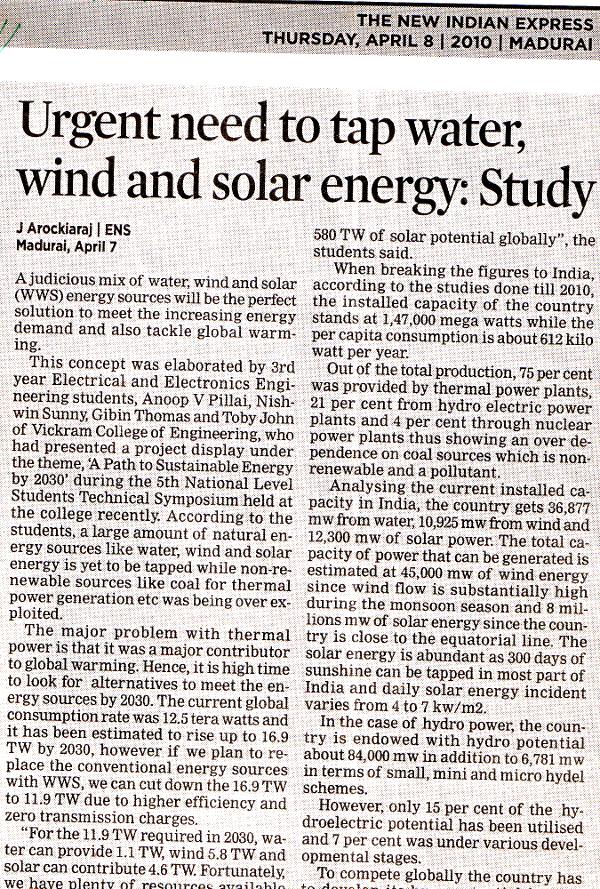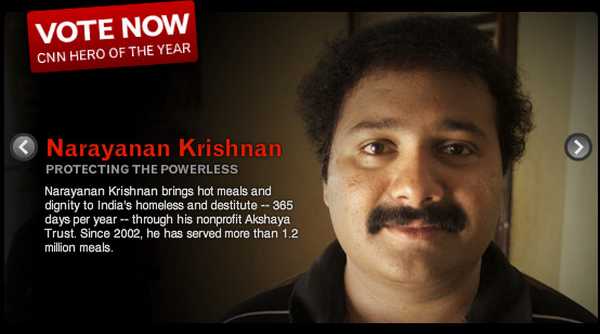- Written by SHEEBA
- Hits: 3016
WIND,WATER,SOLAR 2030: THE SOLUTION TO ENERGY DEMAND
III yr EEE students Anoop.V. Pillai, Nishwin sunny, Gibin Thomas ,Robin Roy,Toby John and team have presented a report on the future of energy resources under the heading “A PATH TO SUSTAINABLE ENERGY RESOURCE BY 2030” during the 5th National Level Technical Symposium held at Vickram College of Engineering. The above report has been published in THE NEW INDIAN EXPRESS daily dated 08-04-2010. We congratulate the students for the above venture.
WWS 2030- A DISPLAY
A brief account of the Project is as follows:
Introduction:Now a days the major problem that our world is facing is global warming and energy crisIs. The major cause behind the Global Warming is the use of Fossil fuels and conventional power generation methods such as thermal,nuclear etc., and we could just scrutinize the use of Fossil fuels by replacing it with renewable energy sources like Water ,Wind and Solar and make it sustainable enough to satisfy the whole world’s power demand by 2030.Hence the research theme is named as WWS 2030.
PRESENT SCENARIO: By the use of Conventional energy resources such a thermal, nuclear etc., we are consuming 12.5 TW (Tera Watt) and is been estimated to rise up to 16.9 TW by 2030 but if we plan to replace conventional energy resource with that of WWS, we could cut down the 16.9 TW to 11.9 TW ,the reasons being higher efficiency and zero transmission losses.
WWS SPLIT UP NEEDED:Of this 11.9 TW ,water can provide 1.1 TW, wind 5.8TW and solar can contribute to meet 4.6 TW. The good thing is that, we have a plenty of resources available untapped ie. About 2 TW of water resources, 40 to 85 TW wind, and 580 TW of solar potential is available across the globe.
DO’S AND DON’T’S: In the path to implement WWS,we need to follow certain Do’s and Dont’s in order to implement it successfully.
1)CHOOSE EMISSION FREE TECHNOLOGY
Technology chosen should be completely emission free. It should not produce any kind of emission during operation and decommissioning. For eg:The carbon emission from nuclear reactor is 25 times more than that of wind energy. Hence we need to consider only technologies that do not present significant waste disposal and terrorism risk.
2) INSTALL MORE NUMBER OF RENEWABLE INSTALLATIONS
For making our vision possible ,we need to construct 49000 of tidal turbines, 5350 geo thermal plants, 900 Hydro electric plants, 38000000 wind turbines and 720000 wave converters. Though the number seems quite huge,this is possible because if, we can make Millions of cars and trucks a year, it is easy for us to manufacture these equipments too.
3)USE RECYCLED METALS TO MANAGE THE MATERIALS HURDLE
As the renewable installations to be manufactured is high so as to satisfy the whole world demand,the question arises about the availability of metals employed to construct these installations. Some rare earth metals,such as lithium, platinum,Neobdymium and silver is needed in large volumes. The only way to overcome this is effective and efficient recycling of these metal s. So production processes can concentrate on strategies and ideas to recycle and replace these metals with abundantly available raw materials wherever possible.
4)USE SMART MIX OF WATER,WIND AND SOLAR INSTEAD OF SINGLE CHOICES
All of us have a serious question in our minds that does the sun shine always and the wind blow continually in all regions?Being a logical query,We could install power plants by making a smart mix of these renewable sources for eg: We could use Geo –thermal or tidal as the base supply along with solar at day and wind at night combined with the hydro electric plant which can be used along with this in such a manner that it could be used to meet our peak time demand. Thus it can be made more economic and reliable and provide way for uninterrupted supply.
ADVANTAGES OF WWS:
COST EFFECTIVE:At present, the total power generation charges is Rs.2.4 per Kilo Watt Hour(KWH) and it is estimated to rise up to Rs 3.84 per KWH by 2030 due to rise in power demands ,if we are going by conventional sources, but if we shift to WWS we could just cut down the rate up to Rs 1.92per KWH since there is no transmission losses as in the case of traditional power generation methods.
LESS DOWNTIME MAINTENANCE:The tradional coal plant suffers 46 Days/yr of downtime maintenance whereas Wind turbines and photovoltaic plants require just 7 Days/yr of downtime maintenance.
In short we conclude that future of energy resources is WWS which is clean, new, cost effective and reliable.
source:This project theme was based on the research undertaken by Stanford University and research article published in 'Scientific American India' magazine-Nov 2009 Issue.
NEWSPAPER EXCERPT:



